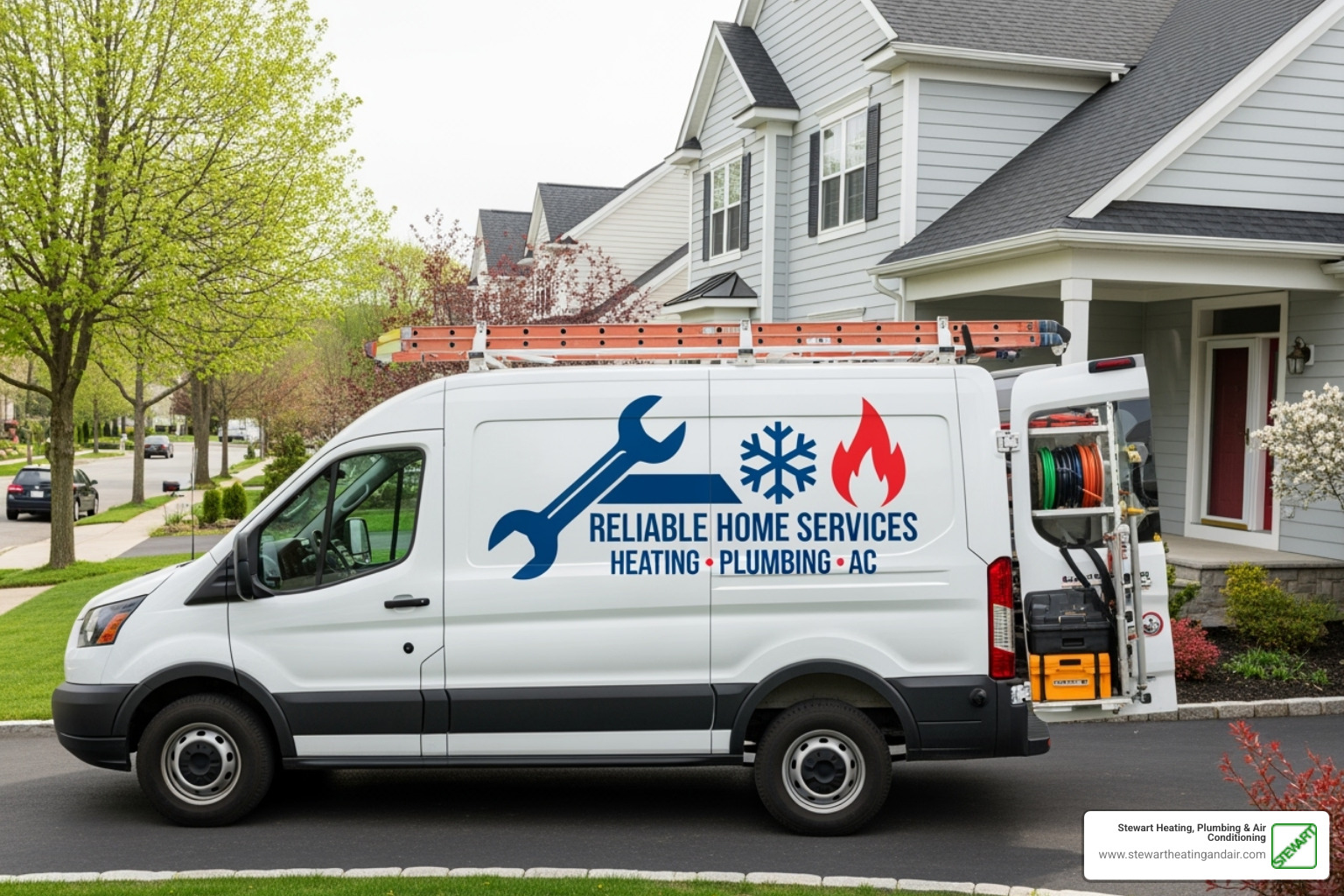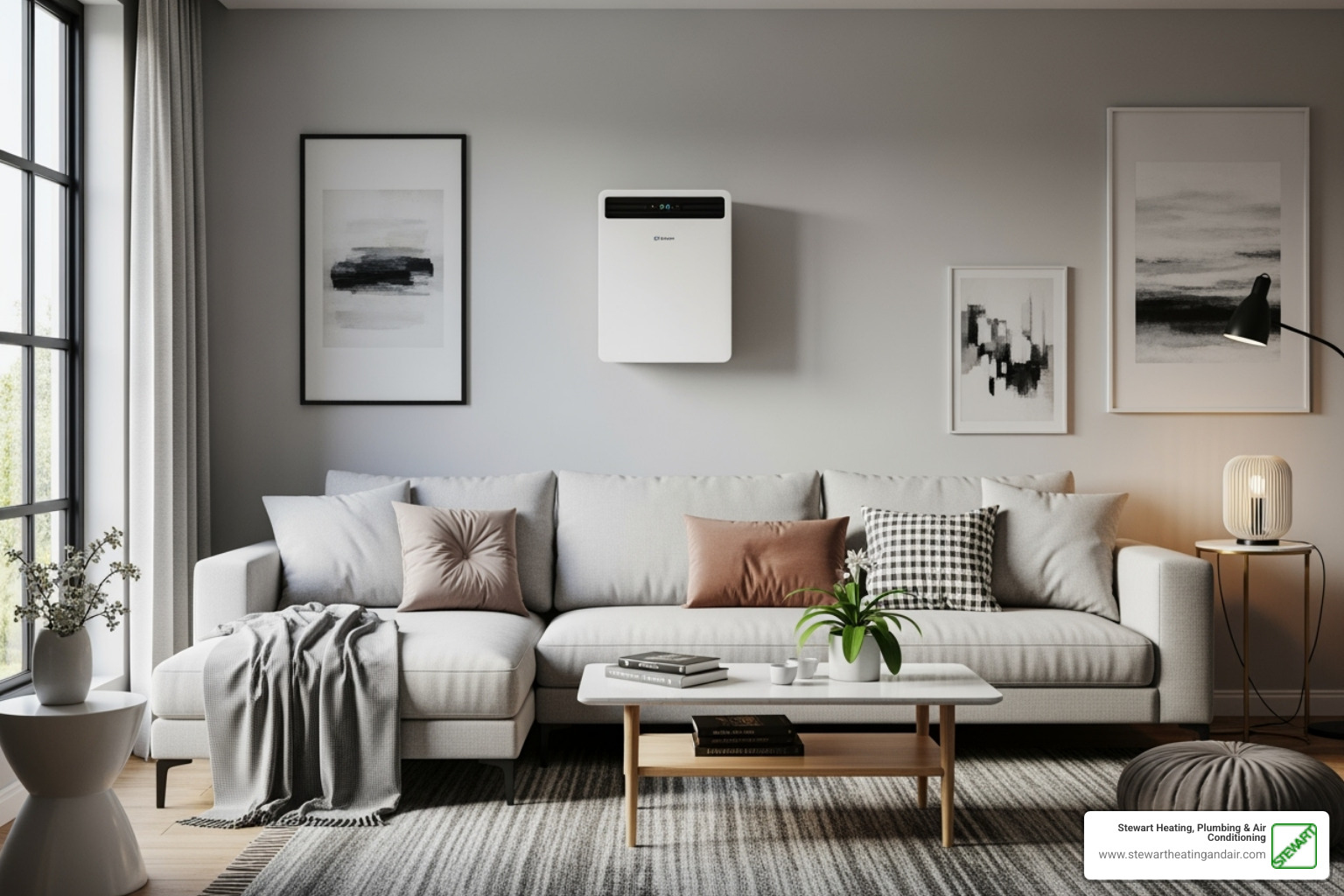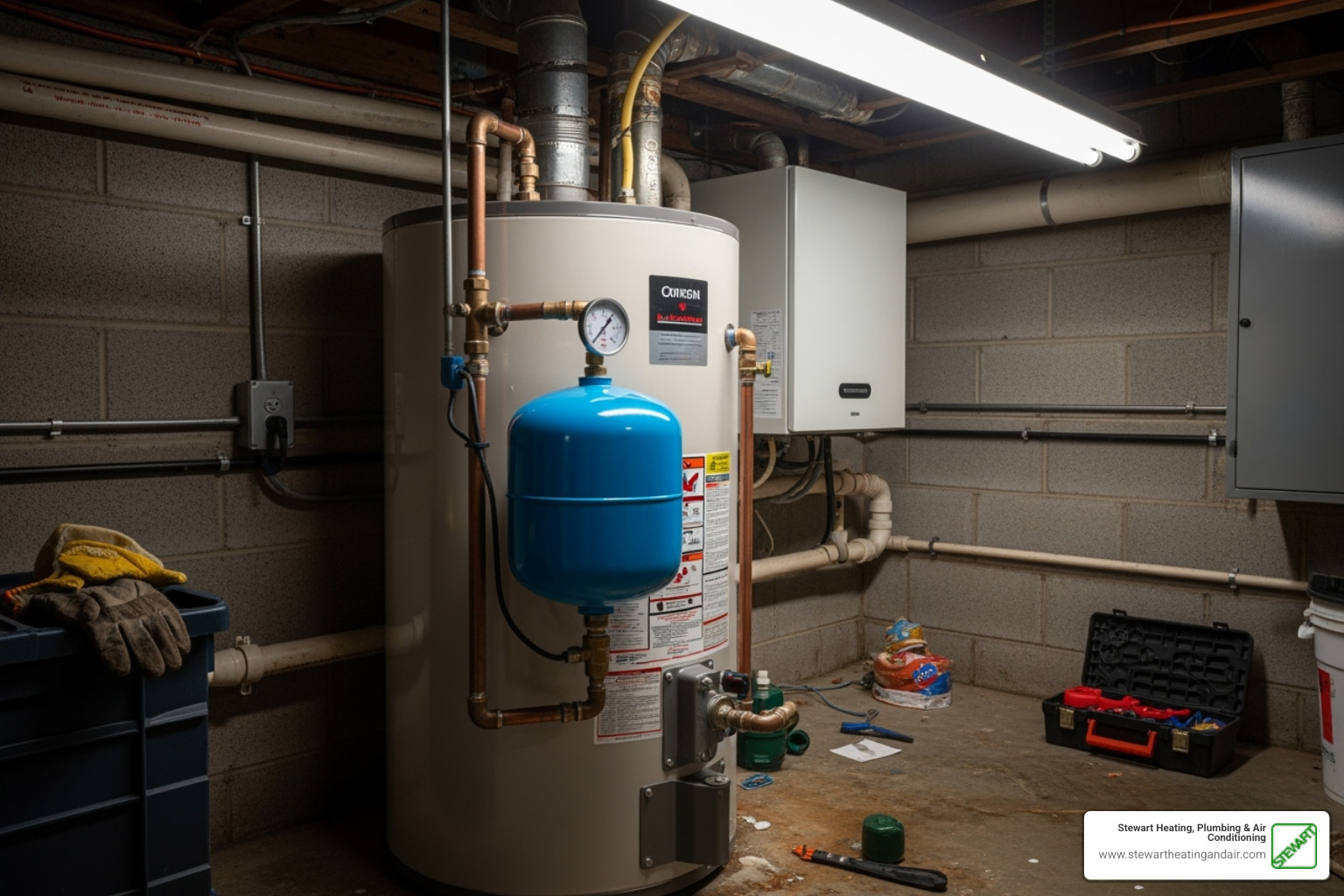
Why Your Water Heater Expansion Tank is Critical for Home Protection
A water heater expansion tank is a small safety device that prevents dangerous pressure buildup in your home's plumbing system when water heats up and expands. Here's what every homeowner needs to know:
Key Functions:
- Absorbs thermal expansion - Water expands by about 2% when heated from 50°F to 120°F
- Prevents pressure spikes - Stops pressure from jumping from 60 PSI to 120+ PSI during heating cycles
- Protects your investment - Prevents premature failure of water heaters, fixtures, and pipes
- Required by code - Mandatory in most areas for new water heater installations in closed systems
When You Need One:
- Your home has a backflow preventer or check valve
- You have a pressure reducing valve (PRV)
- Your T&P relief valve drips frequently
- You're installing a new water heater
In 2007 and 2008, videos of water heater explosions went viral, leading to updated building codes that now require expansion tanks in most new installations. Without this simple device, the pressure from heated water has nowhere to go except through your expensive plumbing fixtures.
Most homes built after 2007 have what's called a "closed plumbing system" due to EPA requirements for backflow prevention. Unlike older "open" systems where excess pressure could flow back into city water lines, closed systems trap that pressure inside your home - making an expansion tank essential for protecting your plumbing investment.
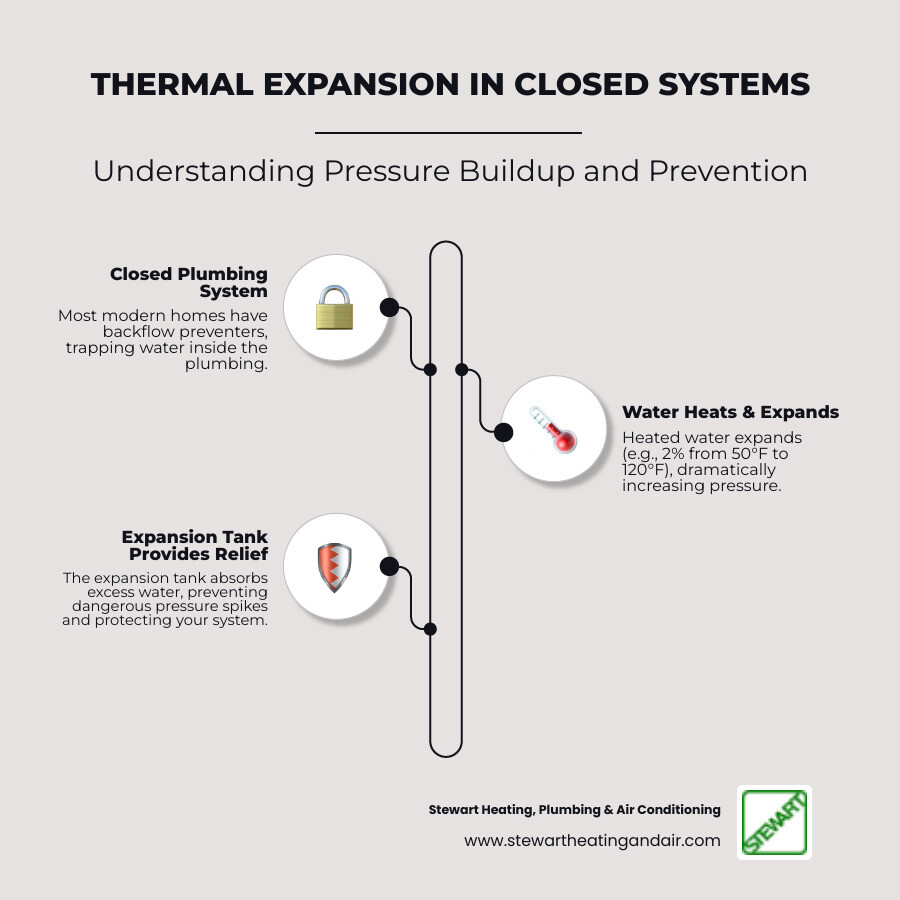
Understanding Your Water Heater Expansion Tank: Function and Necessity
Think of a water heater expansion tank as your plumbing system's best friend - the one that quietly prevents disasters while you go about your daily routine. This unassuming metal tank, usually about the size of a small propane cylinder, connects to your water heater's cold water line and performs one crucial job: giving expanding water a safe place to go.
Here's how this clever device works. Inside every water heater expansion tank sits a flexible rubber bladder that creates two separate chambers - one for water and one for air. When your water heater fires up and heats that cold water, physics takes over. Water expands as it heats up, and since water doesn't compress easily, that extra volume needs somewhere to go.

In a closed plumbing system, that expanding water flows into the expansion tank, gently pushing against the rubber bladder. This compresses the air on the other side, creating a cushion that absorbs the pressure like a shock absorber. The beauty of this design is that the bladder keeps the water and air completely separated - if they mixed, the air would dissolve into the water and your tank would lose its ability to protect your home.
You'll notice a Schrader valve on the air side of the tank - yes, just like on your car tires. This valve lets technicians pre-charge the tank with the right air pressure and test it when needed.
Why do modern homes need these tanks? The answer lies in how plumbing systems have evolved. Your grandfather's house probably had an "open" plumbing system where excess pressure could flow back into the city water lines. But starting in the early 1990s, the EPA began requiring backflow preventers on water meters to protect public water supplies from contamination.
Many homes also have pressure reducing valves (PRVs) that protect your plumbing from high street pressure. While these devices do important jobs, they also create what we call a "closed system" - essentially sealing your home's plumbing off from the outside world.
In a closed system, when water heats up and expands, that pressure has absolutely nowhere to go except to build up in your pipes. Without a water heater expansion tank, your system becomes like a pressure cooker with no release valve. This is why building codes now require expansion tanks for new water heater installations in closed systems - it's not just a suggestion, it's the law.
For homeowners in Pittsburg and throughout Contra Costa County, local regulations follow the International Plumbing Code requirements. If you're experiencing pressure issues or need expert guidance, our team provides professional Water Heater Repair services. You can also find detailed technical information at Water Heater Expansion Tanks.
Why Expansion Tanks are a Modern Requirement
"My old water heater lasted 20 years without an expansion tank - why do I need one now?" It's a question we hear often, and the answer reveals how much plumbing safety has improved over the decades.
The difference comes down to thermal expansion and pressure management. When water heats from 50°F to 120°F, it expands by about 2%. In a 50-gallon water heater, that means an extra gallon of water volume that needs somewhere to go. If your home's normal pressure is 60 PSI, thermal expansion can easily spike it to 120 PSI or higher - well beyond the safe operating range for most plumbing fixtures.
Your water heater does have a built-in safety device called a Temperature and Pressure Relief (T&P) valve. This valve opens if pressure exceeds 150 PSI or temperature hits 210°F, preventing catastrophic failures. But here's the thing - it's designed as an emergency measure, not a daily pressure regulator.
When your system routinely hits high pressures due to thermal expansion, your T&P valve becomes overworked. You'll notice it dripping frequently, which isn't just annoying - it's a sign that your valve is wearing out from constant use. A worn T&P valve might fail when you really need it, putting your home at risk of dangerous pressure buildup.
A water heater expansion tank prevents these pressure spikes before they happen. By absorbing the expanded water volume, it keeps pressure within safe limits and protects everything connected to your water supply. This includes expensive appliances like dishwashers and washing machines, as well as all your fixtures and faucets.
This protection applies to all tank-style water heaters, whether you have Gas Water Heaters or electric models. The expansion tank acts like a shock absorber for your entire plumbing system, extending the life of everything it protects.
Think of it as insurance for your plumbing. The upfront cost is minimal compared to the expensive problems it prevents down the road.
What are the consequences of not having a water heater expansion tank?
Skipping a water heater expansion tank in a closed plumbing system is like playing Russian roulette with your home's plumbing. The consequences start small but can quickly escalate into expensive headaches that affect your entire house.
The first warning sign is usually a dripping T&P valve. While homeowners often see this as a minor annoyance, it's actually your plumbing system crying for help. That constant dripping means your system is regularly hitting unsafe pressure levels. Worse yet, the valve itself wears out from overuse, potentially failing when you need it most.
Premature water heater failure is another costly consequence. High water pressure is one of the leading causes of tank leaks and early replacement needs. The constant expansion and contraction, combined with pressures exceeding design limits, can compromise your tank's lining. This leads to rust, corrosion, and eventually a leak that requires emergency Water Heater Replacement.
But the damage doesn't stop at your water heater. Every fixture and appliance in your home suffers under chronic high pressure:
Damaged fixtures become a recurring expense. Faucets start dripping, showerheads fail prematurely, and toilet fill valves need constant adjustment. These might seem like small repairs, but they add up quickly.
Pipe bursts represent the nightmare scenario. While modern PEX piping is more forgiving, even it has limits. Older copper pipes are especially vulnerable to sudden failures under high pressure. Imagine coming home to a flooded basement or kitchen - a disaster that could have been prevented with a simple expansion tank.
Voided warranties add insult to injury. Some appliance manufacturers will void warranties on dishwashers, washing machines, and other connected appliances if damage results from excessive water pressure - especially when a required expansion tank wasn't installed.
The irony is that a water heater expansion tank costs a fraction of what you'll spend dealing with these problems. It's like choosing between buying a good set of tires or paying for multiple tow trucks and accident repairs. The smart money is always on prevention.
Sizing, Testing, and Lifespan
Getting the most out of your water heater expansion tank means understanding how to size it correctly, test it regularly, and know when it's time for a replacement. Think of it like buying the right size shoes – too small and you'll be uncomfortable, too big and they won't work properly either. This applies to all types of tank-style water heaters, including Electric Water Heaters.
The good news? With a little knowledge and some basic maintenance, your expansion tank can quietly do its job for years, protecting your home's plumbing system around the clock.
How to Choose the Right Water Heater Expansion Tank
Picking the right size water heater expansion tank isn't rocket science, but it does require knowing two key numbers about your home. Getting this right the first time saves you headaches down the road and ensures your system works as intended.
Your water heater's capacity is the first piece of the puzzle. A 40-gallon water heater heats less water than an 80-gallon unit, which means less expansion and a smaller tank requirement. It's straightforward math – more hot water means more expansion, which means you need more room to absorb that extra volume.
Your home's incoming water pressure is equally important. If your city water comes in at 80 PSI instead of 40 PSI, your expansion tank has to work much harder to absorb the pressure spikes from thermal expansion. Higher starting pressure means you need a bigger tank to handle the load.
Most homes with smaller water heaters and normal pressure can get by with a 2-gallon expansion tank. But if you have a larger water heater or higher water pressure, you might need to step up to a 3.2-gallon, 4.4-gallon, or even 5-gallon tank.
| Water Heater Capacity (Gallons) | Incoming Water Pressure (PSI) | Recommended Expansion Tank Size (Gallons) |
|---|---|---|
| 40-60 | < 60 | 2.0 |
| 40-60 | 60-80 | 3.2 |
| 61-80 | < 60 | 3.2 |
| 61-80 | 60-80 | 4.4 |
| 81-120 | < 60 | 4.4 |
| 81-120 | 60-80 | 5.0+ |
Here's a pro tip: when in doubt, go slightly bigger. An oversized water heater expansion tank won't hurt your system's performance, but an undersized one definitely will. It's like having a bigger shock absorber – it can handle whatever you throw at it.
Testing Your Tank and Extending Its Life
Your water heater expansion tank works hard behind the scenes, but like any hardworking piece of equipment, it needs occasional check-ups. Most expansion tanks last between five to ten years, though proper care can help them reach the upper end of that range.
Testing your tank is surprisingly simple and doesn't require calling a professional. The tap test is your first line of defense – grab a wrench handle and tap the top and bottom of the tank. A healthy tank sounds hollow at the top (that's the air chamber) and dull at the bottom (that's where the water sits). If the whole thing sounds dull and water-filled, the internal bladder has likely failed.
Checking the Schrader valve gives you another clue about your tank's health. This little valve looks just like the one on your car tire and sits on the air side of the tank. Gently press the center pin with a key or small screwdriver. If water comes out instead of air, you've got a ruptured bladder and need a replacement tank.
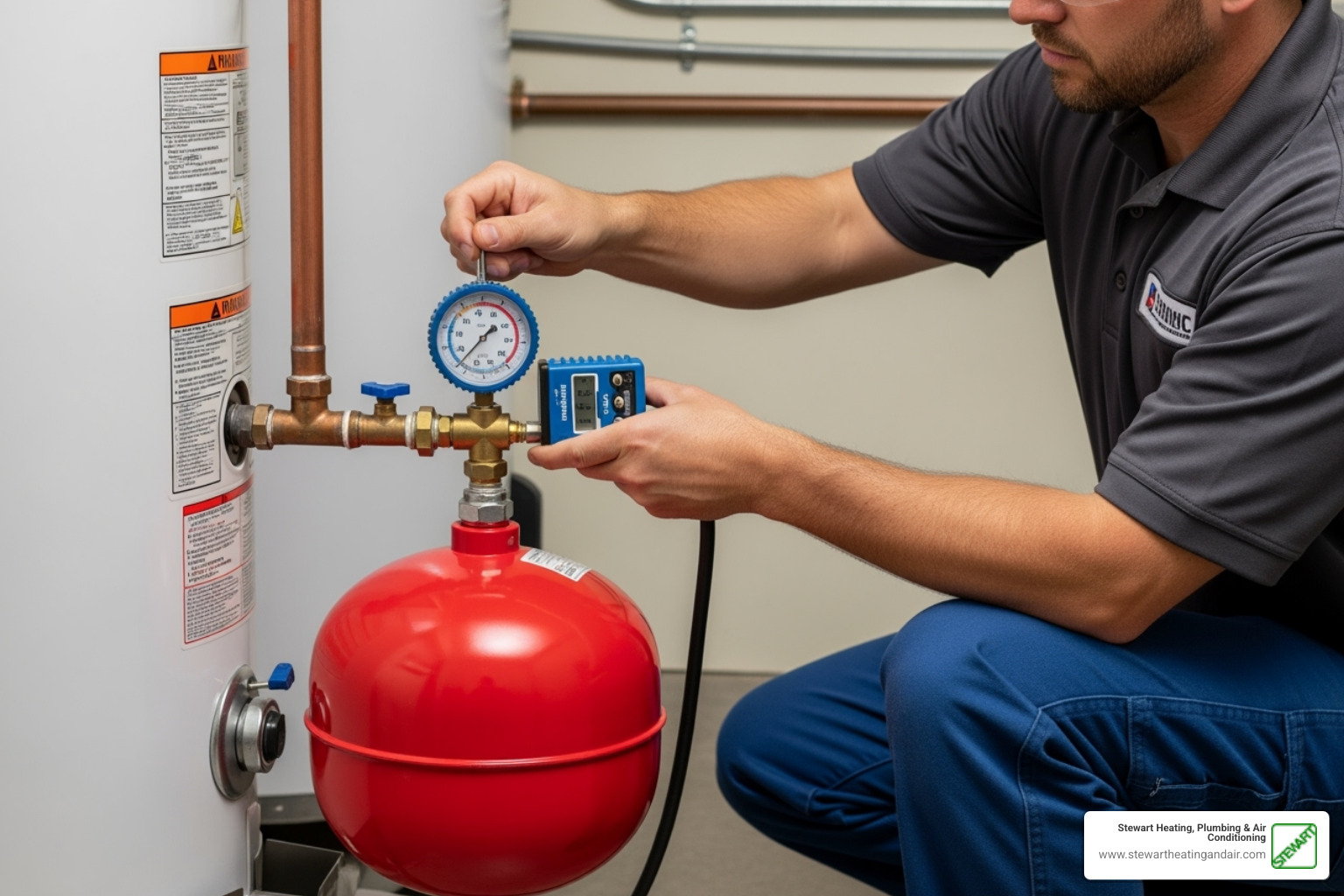
The pressure test requires a bit more work but gives you the most accurate picture of your tank's condition. You'll need to depressurize your plumbing system first by turning off your home's water supply and opening a hot water faucet. Then use a tire pressure gauge on the Schrader valve – the reading should match your home's water pressure. If your house runs at 60 PSI, your tank should be pre-charged to 60 PSI too.
Watch for warning signs that your expansion tank might be struggling. A constantly dripping T&P valve is often the first red flag – it means pressure spikes are happening again. Fluctuating water pressure at your faucets, especially after the water heater runs, can also signal trouble. Water in your water heater's drain pan might indicate system stress from uncontrolled pressure.
The secret to a long-lasting water heater expansion tank is proper pre-charge pressure from day one. A tank that's charged too high or too low won't work right and will wear out faster. We recommend checking this pressure once a year as part of your routine Water Heater Maintenance – it's a small step that can save you from bigger problems later.
Frequently Asked Questions about Water Heater Expansion Tanks
When it comes to water heater expansion tanks, we hear the same questions over and over from homeowners throughout Pittsburg and Contra Costa County. Let's tackle the most common concerns so you can make informed decisions about your home's plumbing protection.
What is the typical cost to install an expansion tank?
The investment in a water heater expansion tank varies based on several factors, but let's break down what you can expect. The tank itself typically ranges from $40 to $200, depending on the size and quality you choose. A standard 2-gallon tank for most homes falls on the lower end of this range, while larger 4.5-gallon tanks cost more.
Here's where timing makes a big difference: if you're installing the expansion tank during a new water heater installation, the additional labor cost is minimal since your plumber is already there working on the connections. It's like adding a side dish when you're already ordering dinner – much more cost-effective than making a separate trip.
However, if you need a standalone installation on your existing water heater, expect higher labor costs since it requires a dedicated service call. While this represents an additional expense, think of it as insurance for your entire plumbing system. The cost of replacing a water heater prematurely, fixing burst pipes, or dealing with water damage far exceeds this upfront investment.
Many homeowners find that when they combine the expansion tank installation with other water heater services, they get the best value for their money. Whether you're handy with tools or prefer professional installation, the peace of mind that comes with proper thermal expansion protection is invaluable.
Are expansion tanks required by plumbing code?
Absolutely – and this isn't just a suggestion from overly cautious plumbers! Water heater expansion tanks are mandated by the International Plumbing Code for closed water systems, and these requirements have been adopted by local jurisdictions across the country, including right here in Contra Costa County.
The code requirement stems from a simple reality: modern homes have closed plumbing systems due to backflow preventers and pressure reducing valves (PRVs). When your water heater heats water in a closed system, that thermal expansion has nowhere to go without an expansion tank. It's not just about following rules – it's about preventing dangerous pressure buildup that can damage your home.
For new water heater installations, expansion tanks are typically required when your home has any device that prevents water from flowing back into the municipal supply. This includes check valves, backflow preventers, or PRVs. If you're unsure whether your home has a closed system, a qualified plumber can quickly assess your setup during a service visit.
Local regulations in areas like Pittsburg follow these safety standards because they work. The Thermal Expansion Flyer from municipal sources explains why these codes exist – they prevent the kind of plumbing disasters that can turn a minor heating cycle into a major repair bill.
The bottom line? If you're installing a new water heater in most modern homes, an expansion tank isn't optional – it's a code-mandated safety requirement.
Can an expansion tank be installed on any type of water heater?
Water heater expansion tanks work with all tank-style water heaters, regardless of whether they run on gas, electricity, oil, or even solar power. The key word here is "tank-style" – these are the traditional water heaters that store and continuously heat 40, 50, 80, or more gallons of water.
The reason expansion tanks work universally with tank-style units is simple: they all face the same challenge of thermal expansion. Whether your water heater burns natural gas or uses electric elements, when it heats that stored water from cold to your desired temperature, the water expands and needs somewhere to go in a closed system.
However, Tankless Water Heaters are a different story entirely. These units heat water on demand rather than storing large volumes of hot water. Since there's no big tank of water constantly expanding and contracting, expansion tanks are typically not needed for tankless installations. There might be very rare exceptions in specific commercial or unusual residential setups, but for typical home tankless installations, you can skip the expansion tank.
So whether you have a gas unit in your garage or an electric model in your utility room, if it's a traditional tank-style water heater, a water heater expansion tank is your friend. It's one of those universal solutions that works across all fuel types and brands – as long as you're dealing with stored hot water, thermal expansion is always going to be a factor that needs management.
Protect Your Home with Professional Installation
Now that you understand how crucial a water heater expansion tank is for protecting your home, let's talk about getting it installed properly. While you might be tempted to tackle this as a weekend DIY project, installing an expansion tank isn't quite as simple as it might seem. There's more to it than just connecting a tank to a pipe – and getting it wrong could leave you with the very problems you're trying to prevent.
Think of it this way: you wouldn't perform surgery on yourself just because you watched a few YouTube videos, right? The same principle applies here. Working with your home's water pressure and plumbing systems requires expertise that comes from years of training and hands-on experience.
When you choose professional installation, you're getting correct sizing that takes the guesswork out of the equation. Our team will carefully assess your specific water heater capacity and measure your home's actual water pressure to determine the perfect expansion tank size. We've seen too many cases where homeowners bought a tank that looked "about right" only to find it couldn't handle their system's demands.
Proper pre-charge is another critical factor that's often overlooked. Schrader valve we talked about earlier? Setting the correct air pressure in that tank before installation is absolutely essential. If it's too low, the tank won't absorb expansion properly. Too high, and it won't work at all. Our technicians know exactly how to match your tank's pressure to your home's incoming water pressure – a step that can make or break the entire system's effectiveness.
Code compliance might not sound exciting, but it's what keeps your family safe and your insurance valid. Plumbing codes in Pittsburg, CA, and throughout Contra Costa County have specific requirements for expansion tank installations. Our licensed plumbers stay current with all these regulations, so you never have to worry about whether your installation meets legal standards or will pass inspection.
Most importantly, professional installation gives you safety and peace of mind. Water under pressure can be dangerous, and working near hot water lines requires knowledge of proper safety procedures. When something goes wrong with a DIY plumbing project, it usually goes very wrong – think flooded basements, damaged walls, or worse.
At Stewart Heating, Plumbing & Air Conditioning, we've built our reputation on doing things right the first time. Our high referral rate isn't an accident – it's the result of consistently delivering quality work that protects our customers' homes and gives them confidence in their plumbing systems. We understand that your home is your biggest investment, and we treat it with the same care we'd want for our own families.
For expert advice and installation of Water Heaters and their essential components like expansion tanks, contact our team. We're here to help you protect your home and ensure your plumbing system works reliably for years to come.
